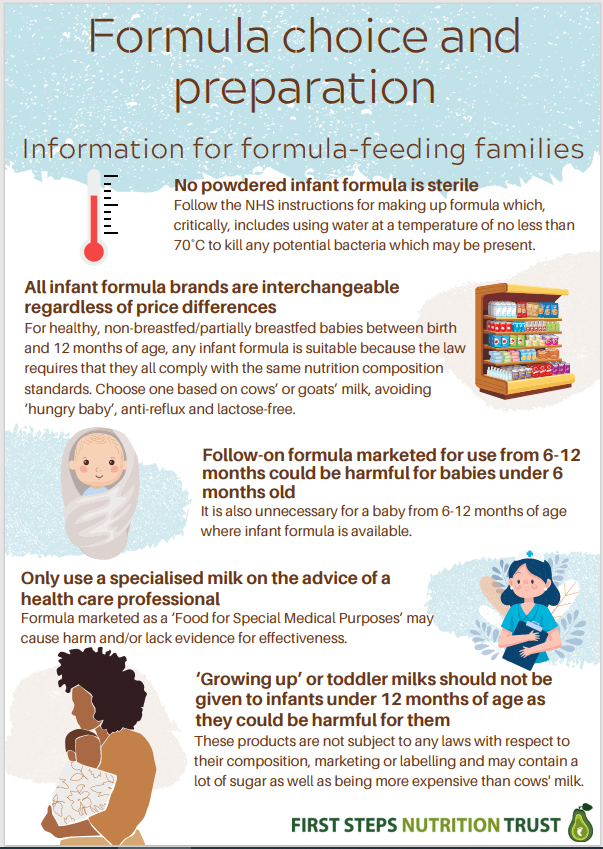

Last Updated - June 30, 2025
Formula Feeding
You may choose to give your baby formula milk, want to combination feed or give your baby expressed breastmilk by bottle. Our service will support you however you choose to feed your baby.
- Making up formula feeds
- Cleaning and sterilising bottles
- Knowing how much to feed your baby; responsive and paced bottle feeding
- Feeding cues
- Skin to skin

Infant formula is usually made from cow’s milk and has been treated to make it suitable for babies. There are many types of formula so always check the label before giving to your baby. However it is recommended to always use first stage milks until at least twelve months when it is recommended that your baby moves on to full fat cow’s milk. Your baby can stay on first stage milk whilst you are introducing them to solids at around six months. Vitamins are added to formula milk. If your baby is taking 500ml or more a day then additional vitamins should not be given.
Formula comes in two forms; ready-made formulas which are sterile and sold in cartons, and powered infant formula which is not sterile and must be made up safely. Instructions for doing this can be found here:
How to bottle feed your baby; responsive and paced feeding
You and your partner should feed your baby to build up a close and loving bond between yourselves.
- Make sure that you are sitting comfortably, always hold your baby close to you and look into their eyes when feeding. This helps the baby feel safe and loved.
- Hold your baby fairly upright for feeds, with their head supported so that they can breathe and swallow comfortably.
- Brush the teat against your babies lips, and when your baby opens their mouth wide, allow them to draw in the teat.
- Gently insert the teat into your baby’s mouth, keeping the bottle in a horizontal position (just slightly tipped), to prevent milk from flowing too fast.
- Allow just enough milk to cover teat and pace the feed to meet babies’ needs, gently removing it if baby appears to want a break and may need to burp.
- If the teat becomes flattened while you are feeding, pull gently on the corner of your baby’s mouth to release the vacuum.
- Your baby will know how much milk they need. Forcing your baby to finish a feed will be distressing, and can mean your baby is overfed.
Hot Weather and Feeding Your Baby
When the weather is hot your baby will want to feed more often as they will be thirsty. This is normal and your milk will adapt and change to be more refreshing but will still have all the same nutrients that your baby needs. Your breastmilk is your baby’s food and drink.
During hot weather, it is important to keep your baby cool. You can do this by dressing them in light clothes and keeping them in the shade.
Breastfed babies (0 to 6 months)
- No extra water is needed for exclusively breastfed babies until solids are introduced.
- During hot weather, your baby will breastfeed more often. These feeds may be shorter and more frequent. Check your baby is staying hydrated by counting the number of wet and dirty nappies they produce.
Formula fed babies (0 to 6 months)
- Formula fed babies may need small amounts of extra water during hot weather. There is no specific guidance on how much extra water. If needed, give a small amount in between milk feeds.
- Tap water is not sterile, it needs to be boiled and cooled first.
- Bottled water may not be appropriate due to high salt (sodium) and sulphate leves
- Filtered water can be given to babies under 6 months, but still needs to be boiled and cooled first.
All babies (6 to 12 months)
- Water can be given from an open cup or beaker at mealtimes from 6 months.
- Tap water can be given without being boiled first.
Very Important
In hot weather keep an eye on how much your baby is weeing and the colour of the wee. If they are producing less wee than usual and it is darker in colour (it should be straw coloured or clear) you should offer breast/expressed breastmilk feeds more often.
